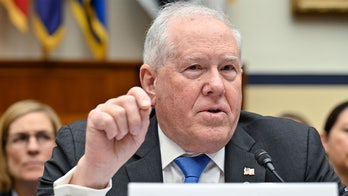
File: Feb. 2014: A farm field in Los Banos, California. (REUTERS)
Several nonprofits that have little to do with farming or are in poor standing with their local governments have been receiving hundreds of thousands of dollars in farm subsidies over the past decade, federal records show.
They include an Islamic charity tied to Nation of Islam leader Louis Farrakhan, a Midwestern group devoted to waterfowl habitat, and a major conservation group with few farms to its name.
The group tied to Farrakhan, called the Three Year Economic Saving Program, has received nearly $160,000 in farm subsidies since 2002. The program was incorporated on Sept. 12, 2001, and is listed as “Not in Good Standing” by Illinois’s secretary of state.
The program has no record of ever being a charity with the Illinois Attorney General Office, which oversees the state’s 501(c)(3) nonprofits. The program nevertheless funded an operation called Muhammad Farms, purchased by Farrakhan in 1995. While Muhammad Farms consists of about 1,500 acres in Georgia, its farm subsidies are received at Farrakhan’s Chicago home.
The Savings Program’s goal, according to its website, is “to provide at least one meal per day, according to the teachings of the Most Honorable Elijah Muhammad for the 40 million black people in America.”
Adam Andrzejewski, founder of OpenTheBooks.com and former Republican candidate for governor of Illinois, questioned the subsidies.
“’Not in good standing’ doesn’t seem to trouble the Cincinnati office of the IRS,” he said. “Why is Farrakhan’s charity allowed to receive federal money? This is no longer about farm policy, it’s merely a transfer mechanism from one set of Americans who pay taxes to another set who know how to game the system.”
OpenTheBooks.com displays taxpayer dollars given to the charity since 2008, and FoxNews.com reviewed raw data since 1995 in the database run by Andrzejewski’s group.
The Savings Program has been listed as “Not in Good Standing” since September of last year. According to the Office of the Illinois Secretary of State, the nonprofit was “involuntarily" dissolved by the State of Illinois on Feb. 1 following its failure to file an annual report within six months of its due date. “Sooner or later, the [Illinois] Department of Revenue will catch up with them during tax time,” said an employee of the Illinois Secretary of State’s Business Services office, who commented on the condition of anonymity. The employee could not comment on the legality of the program’s continued acceptance of donations under the auspices of being a 501(c)(3).
As with other nonprofits accepting subsidies, they ostensibly benefit from their government status in two ways – both by receiving the subsidies and by enjoying tax-exempt status.
The Muhammad Farms website says supporters can donate “tax deductible contributions” to the Three Year Economic Saving Program. Yet the IRS’s public database of 990 forms (which can prove a nonprofit’s tax-exempt status) shows no such listing for either Muhammad Farms, the Nation of Islam or the Three Year Program. Some religious organizations are exempt from filing 990 forms, which may allow the Three Year Economic Program to evade disclosing its assets. Through the Freedom of Information Act, nonprofits are required to provide the past three years’ 990 forms on request, and the Nation of Islam has not returned calls requesting the forms or comment.
The Southern Poverty Law Center calls the Nation of Islam a “black separatist group” and Farrakhan’s rhetoric “deeply racist, anti-Semitic and anti-gay,” stating that the Nation of Islam’s theology includes “innate black superiority over whites.”
Chicago Ducks
About $3.4 million in taxpayer funds have gone to foundations based in Chicago that seek to conserve waterfowl at the Putnam County, Ill., Dixon Waterfowl Refuge. Since 2001, seven waterfowl habitat foundations have received roughly $50,000 per year. Each foundation is an arm of the Wetlands Initiative, a program that, according to its website, is “dedicated to restoring the wetland resources of the Midwest.”
Each of the seven separate foundations is run out of the same downtown Chicago high-rise office, has the same agent, shares the same IRS 990 filer and receives subsidies from the same USDA county office. Subsidies flow from the Putnam USDA office because the money goes to a waterfowl refuge overseen by the Wetlands Initiative in the same county.
The seven foundations are each dedicated in name to the Pintail, Ringbill, Blue-Wing Teal, Green-Wing Teal, Wood, Mallard and Gadwall ducks— none of which are endangered. Each of these ducks’ situations is labeled “of the least concern” by the International Union for Conservation of Nature. Only two of these ducks are in the Midwest year-round; the other five migrate briefly through the Midwest or are there for one season annually at most.
According the finance manager of the Wetlands Initiative, the seven foundations are named for ducks seen at Hennepin’s Dixon Waterfowl Reservation, which is owned nearly entirely by the seven foundations, and their subsidies are set to expire in October 2015. The Ringbill Habitat Foundation, according to the manager, has the most assets as it owns the most land. The finance manager did not respond to questions regarding why there are seven foundations, and not one.
Group Compensated for Lamb Slaughter, Tobacco Loss
The National Audubon Society, a conservation-focused nonprofit headquartered in downtown Manhattan, has pulled in hundreds of thousands of dollars over the years in federal payments.
The society is the largest recipient of farm subsidies in New York’s SoHo neighborhood, having collected roughly $763,000 over the last decade.
The group’s payment recipients span eight states. Since 1995, about 90 percent of the foundation’s $932,801 in farm subsidy payments have gone to conservation, while about $114,000 was dedicated to crop and livestock payments.
The National Audubon Society’s benefits include crop payments for corn, barley, oats, sorghum, soybeans, cotton, wheat, oilseed, burley and sunflowers. The foundation received a $30 lamb meat slaughter subsidy in 2003 and has received $576 for tobacco loss assistance since 1995. The tobacco loss assistance program was introduced to help farmers regain money lost due to slashed U.S. tobacco quotas and acreage.
In the eight states the payments flow to, just one farm affiliated with the society could be found during a review by FoxNews.com. Dayton, Ohio’s, Aullwood Farm has received no more than $3,224 of the $114,000 in payments since 1995. The farm does raise lamb, which could explain the lamb slaughter subsidy. The farm also raises grass crops, which could cover some, but not all, of the payments the National Audubon Society has received.
The Minnesota chapter of the Society has received over $6,000 in various payments over the last decade, but the National Audubon site does not list any centers or sanctuaries in the state.
According to its 990 form, the foundation’s 26 “key employees” are collectively compensated with more than $8 million each year. The society’s president earns a salary of over $460,000.
The National Audubon Society did not return requests for comment.




